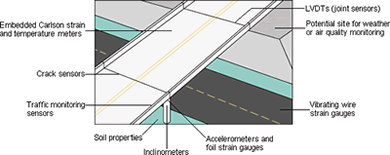What We Do
Check out some awesome examples of what our equipment can do in this area
Customise a System
In addition to our standard systems available, many of the systems we provide are customised. Tell us what you need, and we’ll help you configure a system that meets your exact needs.
More Details about Our Bridge Monitoring Systems
Bridges Monitored By Our Dataloggers
- James Joyce Bridge—Dublin, Ireland
- Bronx Whitestone Bridge—New York, NY
- Brooklyn Bridge—New York, NY
- Verrazano Narrows Bridge—New York, NY
- Williamsburg Bridge—New York, NY
- Throgs Neck Bridge—New York, NY
- Medway Bridge—Kent, UK
- Menai Bridge—North Wales
- Confederation Bridge—Prince Edward Island, Canada
- I-83 Ramp—Harrisburg, PA
- Birmingham Bridge—Pittsburgh, PA
- Sawmill Run Bridge—Pittsburgh, PA
- Neville Island Bridge—Pittsburgh, PA
- SR 33 Bridge—Easton, PA
- Girard Point Bridge—Philadelphia, PA
- Church Street Bridge—Melbourne, Australia
- David Trumpy Bridge—Queensland, Australia
- 15 Mile Creek Bridge—The Dalles, OR
- I-5 Mckenzie Bridge—Eugene, OR
- Willamette River Bridge—Willamette, OR
- I-64 over Kanawha River—Charleston, WV
- AMTRAK Susquehanna River Bridge—Perryville, MD
Bridge Monitoring and Control
The versatility of our systems allows them to be customized for each application. We offer a range of dataloggers, from the most basic system with just a few channels to expandable systems that measure hundreds of channels. Scan rates can be programmed from a few hours to 100,000 times per second, depending on the datalogger model. Measurement types, recording intervals, and processing algorithms, are also programmable. Dataloggers not only provide advanced measurement capabilities, but can also control external devices.
Onboard processing instruction sets contain programmed algorithms that process measurements and output results in the desired units of measure. For example, data can be displayed as rainflow or level crossing histograms. These rainflow and level crossing algorithms allow processing for extended periods of time, not just a limited number of cycles. The instruction sets also allow for triggered output with pretrigger data capture capability. Triggers can be based on sensor output, time, and/or user control. For example, if an overpass is being monitored, data collection can be triggered by a sensor detecting the approach of a car, an earthquake, pre-programmed times, or by pushing a button.
The control functions of our dataloggers combined with their programmability allow them to sound alarms, actuate electrical devices, or shut down equipment based on time or measured conditions. Systems can also call out to phones, pagers, radios, and other devices to report site conditions. Voice-synthesized modems are available, so the system can actually call and tell you what is happening.
Sensors used in Bridge Monitoring
Because our dataloggers are compatible with nearly every commercially available sensor, you can use the sensors that best meet your application. Typical sensors used for structural and seismic monitoring by our systems include:
- Carlson strain meters
- vibrating wire strain gauges
- foil strain gauges (set up in quarter, half, or full bridge strain configurations)
- inclinometers
- crack and joint sensors
- tilt sensors
- piezoresistive accelerometers
- piezoelectric accelerometers
- capacitive accelerometers
- borehole accelerometers
- servo force balance accelerometers
Because our dataloggers have many channel types and programmable inputs, all these sensor types can be measured by one datalogger. Channel types include analog (single-ended and differential), pulse counters, switched excitation, continuous analog output, digital I/O, and anti-aliasing filter. Using switched or continuous excitation channels, our dataloggers provide excitation for ratiometric bridge measurements.
Our configurable datalogger models, the CR9000X and CR9000XC, allow you to customize a system with the channel types that best fit your application. The number and type of channels on most of our dataloggers are expandable using multiplexers and other measurement peripherals. Our dataloggers have input resolutions to 0.16 microvolts, allowing strain measurements with a resolution of a single micro-strain.
Communications
The availability of multiple communications options for retrieving, storing, and displaying data also allows systems to be customized to meet exact needs. On-site communication options include direct connection to a PC or laptop, PC cards, storage modules, and datalogger keyboard/display. Telecommunication options include short-haul, telephone (including voice-synthesized and cellular), radio frequency, multidrop, and satellite.
Software
Our Windows-based software simplifies datalogger programming, data retrieval, and report generation. The datalogger program can be modified at any time to accommodate different sensor configurations or new data processing requirements.
Example Application: Monitoring an Overpass
Campbell Scientific's monitoring systems are used for a variety of structural and seismic applications. Monitoring possibilities on an overpass include:

Case Studies
In the intricacies of transportation networks, bridges take center stage, knitting together communities and ensuring......read more
The Hong Kong-Zhuhai-Macao Bridge (HZMB)—comprising viaduct bridges, cable-stayed bridges, a submerged tunnel, and artificial islands—is......read more
The Delaware Department of Transportation (DelDOT) notified Intelligent Infrastructure Systems (IIS) and Pennoni of the......read more
The Oregon Department of Transportation (ODOT), as part of its statewide structural health monitoring (SHM)......read more
Kamal’s Bridge in Tualatin, a steel box-girder bridge with four spans, was included as part......read more
The Bridge Engineering Section of the Oregon Department of Transportation (ODOT) developed a structural health......read more
The Utah Department of Transportation is investigating the effect on the life span of bridges......read more
The Shippingport Bridge spans the Ohio River in Beaver County, Pennsylvania. Constructed in 1961, the......read more
Related Documents
Related FAQs
Number of FAQs related to Bridge Monitoring: 1
-
Most Campbell Scientific systems are built from individual components. This provides maximum flexibility for our customers, but it does not lend itself to pricing a "typical" system. Contact an application engineer at Campbell Scientific for assistance in pricing a system to meet the unique needs of the application.











